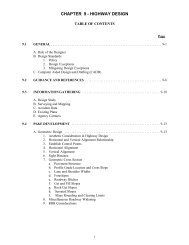Baltimore-Washington Parkway Widening Feasibility Study
Baltimore-Washington Parkway Widening Feasibility Study
Baltimore-Washington Parkway Widening Feasibility Study
- No tags were found...
You also want an ePaper? Increase the reach of your titles
YUMPU automatically turns print PDFs into web optimized ePapers that Google loves.
<strong>Baltimore</strong>-<strong>Washington</strong> <strong>Parkway</strong> <strong>Widening</strong> <strong>Feasibility</strong> <strong>Study</strong>Conclusions9.0ConclusionsCongress provided the FHWA, NPS, and Maryland SHA with a very narrow study focus: to determine thefeasibility of widening the B-W <strong>Parkway</strong> to a six-lane divided facility from <strong>Washington</strong>, DC, to <strong>Baltimore</strong>,Maryland. The following is a summary of the findings.9.1<strong>Feasibility</strong>Criteria#1PhysicalConstraintsIn sections where widening might occur, new or re-constructed infrastructure will most likely beneeded. In locations where the <strong>Parkway</strong> passes under a cross street, bridges will need to be replaced.In locations where the <strong>Parkway</strong> passes over a cross street, bridges will need to be widened. Most of theexisting B-W <strong>Parkway</strong> interchanges will need to be modified or replaced.There are some locations, such as in the Greenbelt area, where the limits of disturbance appear toencroach close to or outside of the existing <strong>Parkway</strong> right-of-way. There were also several sectionsnoted where an inside widening concept is likely not feasible due to the lack of median width availablefor widening of the <strong>Parkway</strong>. Many locations may require design exceptions in order to avoid completereconstruction given the physical constraints of the corridor.9.2<strong>Feasibility</strong>Criteria#2EnvironmentalAnalysisandEffectsEach of the four widening options would have direct effects on all evaluated environmental elements:parklands and recreation areas, including the B-W <strong>Parkway</strong> itself; wetlands and water resources; knowncultural resources, including the B-W <strong>Parkway</strong>; forest and ecology; and residential, commercial, andinstitutional property impacts. Quality-of-life impacts such as view sheds, noise, and aesthetics areanticipated to be greatest with either of the two outside widening options that were considered.The No-Build option would have no direct environmental impacts; however, the B-W <strong>Parkway</strong> userexperience is likely to be affected by worsening traffic conditions as more travelers attempt to use theexisting roadway.9.3<strong>Feasibility</strong>Criteria#3TrafficandTransportationThe traffic and transportation analysis results revealed the following major findings:Traffic conditions along most sections of the B-W <strong>Parkway</strong> are generally worse in the PM peakhour than in the AM peak hour, both today and in the future;.The distribution of traffic “hot spots” in future years continues to be consistent with directionaltraffic distribution in the AM and PM peak periods.<strong>Widening</strong> of the B-W <strong>Parkway</strong> as proposed under the 2040 Partial-Build and 2040 Full-Buildscenarios may provide some localized improvement to traffic operations, but regionally the levelof traffic congestion is anticipated to change little from the 2040 No-Build conditions as widenedsections exhibit a sharp increase in traffic volumes.72 November 2012
















